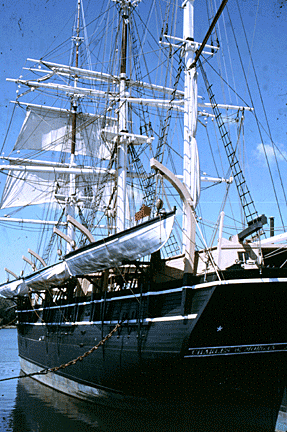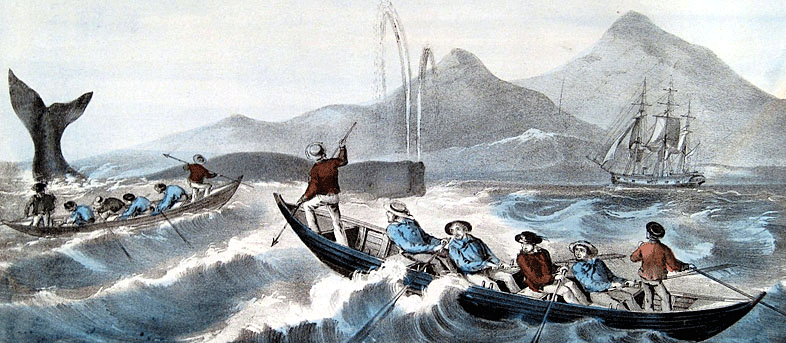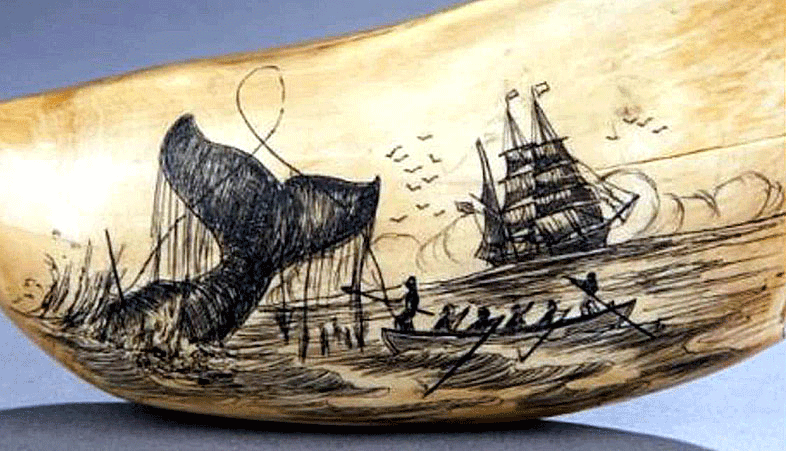|
 While
some occupations have changed little over the centuries, others have
disappeared entirely. Whaling is one of those long-gone occupations. While
some occupations have changed little over the centuries, others have
disappeared entirely. Whaling is one of those long-gone occupations.
By 1846, whaling was the second-largest industry in New
England, with 730 ships and millions of dollars in profits. At its height in
1857, 43 ports registered whaling ships in the Northeast. The industry
employed more than 10,000 seamen, and thousands more worked as coopers,
carpenters, rope and sail makers, and boat builders.
To get men to work on whaling vessels, owners posted
advertisements near port towns: "Chance of a Lifetime" or
"Come See the World." Because of the dangers, small pay and years
at sea, whaling most often attracted men who couldn’t find other work–poor
whites, Indians, former slaves.
No work anywhere in America was so integrated, but it was
harsh reality and not good intentions that brought crews together.
"Whaling was the most dangerous job on the sea that has ever
existed," said Michael P. Dyer, curator of maritime history at the
Kendall Whaling Museum, in Sharon, Massachusetts. "There was no romance
associated with it at all. It was brutal. Few men wanted to do it.''
Ships' records tell the day-to-day stories of long
voyages, of years at sea, of the killing and butchering of whales, and of
other ships sighted and islands visited. But they also tell the stories of
captains killed by whales, crewmen drowned or their limbs ripped off by
ropes, of ships lost in ice floes or wrecked on uncharted shoals.

The whaling industry, which brought millions of dollars in
profits to the Northeast in less than 30 years before the industry's sudden
collapse in the 1860s, was documented in precise detail. Captains kept
journals of exactly where their boats were, what they saw, how many whales
were killed and how many got away.
But captains weren’t the only ones who kept records.
Often, their wives went along on voyages and kept diaries. Some crew members
also kept diaries showing every event that occurred during months at sea.
 Butchering a whale was ugly, bloody work. The dead whale
would be towed alongside the ship, where its thick blubber would be stripped
off with long poles that looked like spades.The thick, rubbery blubber would be carried over to the ``tryworks,''
where it would be boiled in large vats, and the oil poured into barrels. The
bones would be shipped to manufacturers for use in such items as shoehorns,
gentlemen's collars, umbrella stays and hoops in women's dresses. Butchering a whale was ugly, bloody work. The dead whale
would be towed alongside the ship, where its thick blubber would be stripped
off with long poles that looked like spades.The thick, rubbery blubber would be carried over to the ``tryworks,''
where it would be boiled in large vats, and the oil poured into barrels. The
bones would be shipped to manufacturers for use in such items as shoehorns,
gentlemen's collars, umbrella stays and hoops in women's dresses.
A whalman’s pay was abysmal. What a ship brought back in
terms of profit depended on how much oil and bone it collected -- and,
specifically, how much sperm oil, which was more valuable -- and what price
it brought at the time. For example, oil prices ranged from a few cents a
gallon some years to more than $2 a gallon in the 1860s, when whaling was
scaled back because of the Civil War.
"Traditionally, the profit was divided into
thirds," said Scott. "One third went to the owners and agents, one
third went to upkeep of the ship, and one third went to the captain and
crew. The captain would get a larger share of that one-third than a crewman.
Some crewmen got 1/200th or 1/225th. A captain might get a 10th or a 16th.
But if you were at sea for two years or more, the money wasn’t much."

Events conspired to cripple the whaling industry–the
discovery of gold in California in 1848 and the discovery of oil in
Pennsylvania in 1859. The former caused a flood of men who otherwise might
have worked on whalers to go west. The latter created a new supply of oil
almost overnight
While the market for whale oil died in the 1850s, the
market for baleen -- whalebone -- lived on until 1908. That year, a new type
of woman's dress was invented that didn’t need thin strips of whalebone to
keep it billowy. And corsets, which used stays made of baleen, went out of
fashion, too. And with it, an industry died.
|
